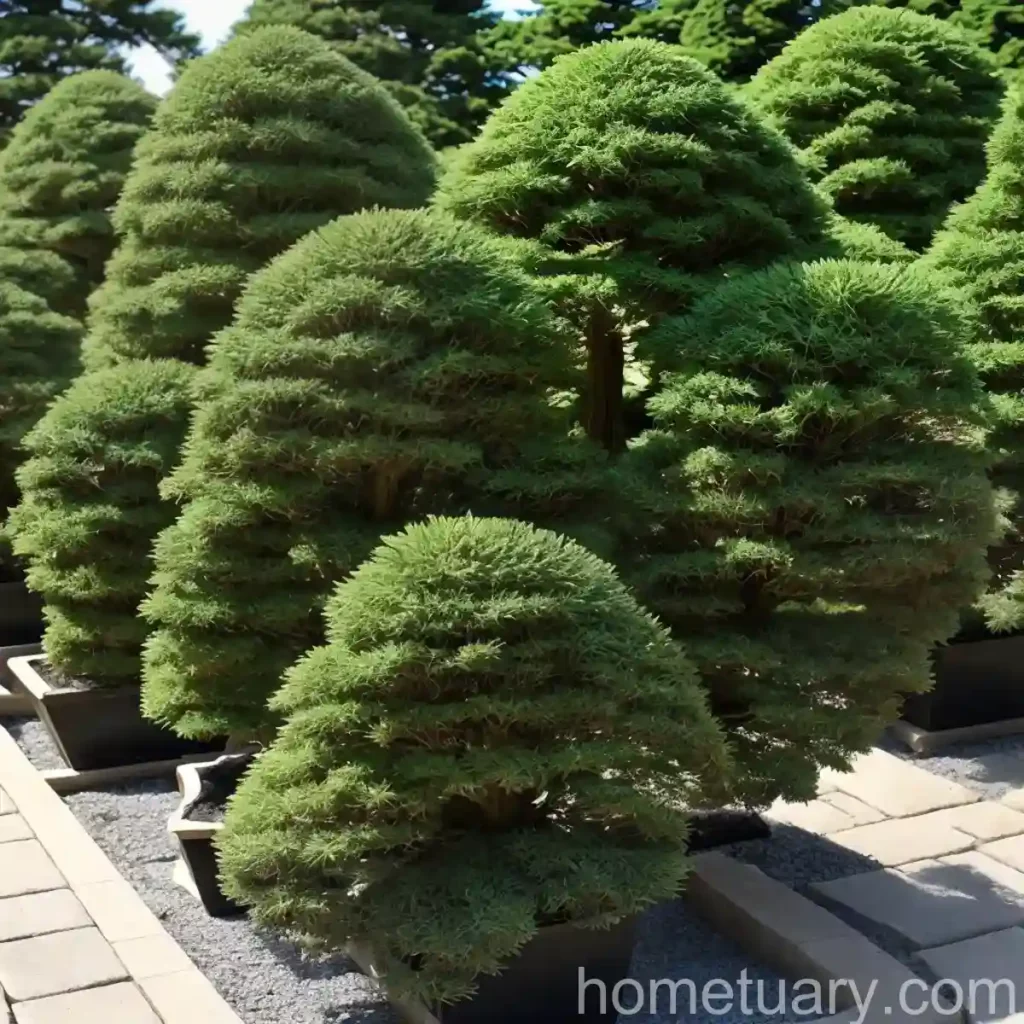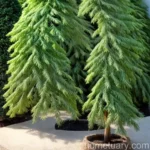Japanese Cedar (Cryptomeria japonica ‘Spiralis’): A Comprehensive Guide
Cryptomeria japonica ‘Spiralis’, commonly known as Japanese cedar, is an elegant and distinctive conifer with striking foliage. Its unique spiraling needles and graceful form make it a popular choice for landscape design and horticultural enthusiasts. This comprehensive guide aims to provide valuable insights into the culture, uses, care, and maintenance of the Japanese cedar, with a focus on the ‘Spiralis’ cultivar.
What is the Japanese Cedar (Cryptomeria japonica ‘Spiralis’)?
Cryptomeria japonica, belonging to the family Cupressaceae, is a species of conifer native to Japan and China. The ‘Spiralis’ cultivar is known for its tightly arranged, spiral-shaped foliage, which sets it apart from other Japanese cedar varieties. This evergreen tree exhibits a moderate growth rate, ultimately reaching a height of 10 to 20 meters with a slender, pyramidal shape.
Key Takeaways – Japanese Cedar (Cryptomeria japonica ‘Spiralis’)
Before delving into the detailed aspects of cultivating and caring for the Japanese cedar ‘Spiralis’, let’s highlight some key takeaways.
- Common Name: Japanese Cedar
- Botanical Name: Cryptomeria japonica ‘Spiralis’
- Foliage: Distinctive spiral-shaped needles
- Growth Habit: Slender, pyramidal tree
- Uses: Ornamental, landscaping, timber
- Water Needs: Moderate
- Sunlight: Full sun to partial shade
- Soil Type: Well-draining, acidic
- Pruning: Minimal, primarily for shaping
- Propagation: Seeds, cuttings
- Container Gardening: Suitable for large containers
- Common Pests: Aphids, spider mites
- Common Diseases: Root rot, needle blight
- Winter Care: Protect from harsh winds and frost
- Botanist’s Tips: Regular watering in the initial years, minimal pruning, protect from extreme weather conditions
Now, let’s explore each of these aspects in detail to gain a comprehensive understanding of the Cryptomeria japonica ‘Spiralis’ and its cultivation requirements.
Culture of Japanese Cedar (Cryptomeria japonica ‘Spiralis’)
Cultivating and caring for the Japanese cedar ‘Spiralis’ involves attention to specific cultural requirements, including watering, sunlight, soil, and fertilizer.
Water
Sufficient moisture is crucial, especially during the initial years of establishment. While the Japanese cedar exhibits moderate drought tolerance once established, regular watering is essential for the first few years. Maintaining evenly moist, but well-draining soil is imperative to prevent waterlogging, which can lead to root rot.
Sunlight
Japanese cedar ‘Spiralis’ thrives in full sun to partial shade. It is best suited for locations with ample sunlight, although it can tolerate some shade. However, to ensure optimal growth and the development of its characteristic spiral foliage, providing adequate sunlight is recommended.
Fertilizer
A balanced, slow-release fertilizer applied in spring is beneficial for the growth and health of the Japanese cedar. Opt for a fertilizer specifically formulated for acid-loving plants to meet its nutrient requirements. Following the manufacturer’s instructions regarding application rates and frequency is advisable to prevent over-fertilization.
Soil
The Japanese cedar prefers acidic, well-draining soil. It thrives in moderately fertile soils with a pH range of 5.0 to 6.5. Amending the soil with organic matter such as compost or peat moss can enhance its texture and fertility, promoting healthy growth.
Pruning
Minimal pruning is generally required for the Japanese cedar ‘Spiralis’. The primary objective of pruning is to maintain its desired shape and remove any damaged or diseased branches. It is advisable to prune in late winter or early spring before the onset of new growth. Additionally, selective thinning can be performed to enhance air circulation within the canopy, reducing the risk of fungal diseases.
Propagation
Cryptomeria japonica ‘Spiralis’ can be propagated from seeds or cuttings. While growing Japanese cedar from seeds is a viable option, it requires patience as the germination process can be slow. Alternatively, softwood cuttings taken in early summer can be rooted to obtain new plants. Implementing proper propagation techniques and providing suitable growing conditions are essential for successful establishment.
Container Gardening
The Japanese cedar ‘Spiralis’ is well-suited for container gardening, making it a versatile choice for patios, urban landscapes, and small gardens. When cultivating it in containers, ensure the pots are spacious enough to accommodate its mature root system. Select a high-quality, well-draining potting mix and incorporate a layer of mulch to conserve soil moisture and regulate temperature fluctuations.
Uses of Japanese Cedar (Cryptomeria japonica ‘Spiralis’)
The Japanese cedar ‘Spiralis’ offers a multitude of uses, ranging from ornamental landscaping to timber production. Its versatile attributes make it a valuable addition to diverse settings.
-
Ornamental Tree: The striking, spiral-shaped foliage and elegant form of the Japanese cedar ‘Spiralis’ make it an eye-catching focal point in gardens and landscapes. Its unique appearance adds visual interest and texture to the surroundings.
-
Timber Production: Cryptomeria japonica is renowned for its high-quality wood, commonly referred to as “sugi.” The wood is utilized in construction, carpentry, and the production of traditional Japanese items such as furniture and shoji screens.
Common Diseases and Pests
As with any plant, the Japanese cedar ‘Spiralis’ is susceptible to certain diseases and pest infestations. Understanding these potential threats is crucial for implementing preventive measures and prompt intervention when necessary.
Common Diseases
-
Root Rot (Phytophthora): Prolonged waterlogging or poorly drained soil can lead to root rot, causing wilting, yellowing foliage, and overall decline. Adopting proper watering practices and ensuring adequate soil drainage can mitigate the risk of this disease.
-
Needle Blight: Several fungal pathogens can cause needle blight, resulting in browning, dieback, and premature shedding of needles. Implementing appropriate cultural practices, such as maintaining proper spacing between plants and promoting good air circulation, can help minimize the incidence of needle blight.
Common Pests
-
Aphids: These small, sap-sucking insects can infest the foliage of the Japanese cedar, leading to distorted growth and the secretion of sticky honeydew. Natural predators and regular monitoring can aid in controlling aphid populations.
-
Spider Mites: Spider mites are common pests that thrive in hot, dry conditions. They cause stippling and discoloration of the needles, potentially weakening the plant. Mitigating environmental stress and practicing periodic hosing of the foliage can deter spider mite infestations.
Botanist’s Tips for Japanese Cedar (Cryptomeria japonica ‘Spiralis’)
Armed with insights from botanical expertise, incorporating the following tips into the care and maintenance of the Japanese cedar ‘Spiralis’ can contribute to its overall health and vitality.
-
Regular Watering: Pay close attention to watering, especially during the establishment phase, to promote robust root development and sustained growth.
-
Minimal Pruning: Exercise restraint when pruning the Japanese cedar ‘Spiralis.’ Only perform necessary pruning for shaping and removing dead or damaged branches to maintain its natural form.
-
Protection from Harsh Weather: Shield the plant from extreme weather conditions, particularly strong winds and frost, which can potentially damage its delicate foliage.
Fun Facts about Japanese Cedar (Cryptomeria japonica ‘Spiralis’)
Apart from its ornamental and utilitarian value, the Japanese cedar ‘Spiralis’ is accompanied by fascinating qualities and historical significance.
-
The wood of Cryptomeria japonica, particularly the ‘Sugi’ variety, has been traditionally used in the construction of temples and shrines in Japan, reflecting its cultural and architectural importance.
-
In Japanese culture, Cryptomeria japonica holds symbolic value and is associated with longevity, strength, and resilience, rendering it a revered and cherished species.
-
The distinctive spiral foliage of the ‘Spiralis’ cultivar makes it a captivating specimen that captivates the attention of garden enthusiasts and admirers of unique botanical features.
Links to External Resources
To further expand your knowledge and understanding of the Japanese cedar (Cryptomeria japonica ‘Spiralis’), consider exploring the following external resources:
- Royal Horticultural Society – Cryptomeria Japonica Cultivation
- University of Florida IFAS Extension – Cryptomeria Japonica Information
- Missouri Botanical Garden – Japanese Cedar Care Guide
- American Conifer Society – Cryptomeria Cultivation and Uses
- The Spruce – Guide to Growing Japanese Cedar
By utilizing these resources, you can uncover additional insights, detailed care guidelines, and practical tips for the successful cultivation of the Japanese cedar ‘Spiralis.’
In conclusion, the Japanese cedar (Cryptomeria japonica ‘Spiralis’) stands as a captivating and versatile addition to diverse landscapes and horticultural settings. Its unique foliage, cultural significance, and versatile uses make it a plant of immense horticultural and aesthetic value. By adhering to the recommended cultural practices, incorporating botanist’s tips, and vigilantly safeguarding against potential diseases and pests, enthusiasts can relish the grace and allure of this remarkable conifer in their outdoor spaces.















